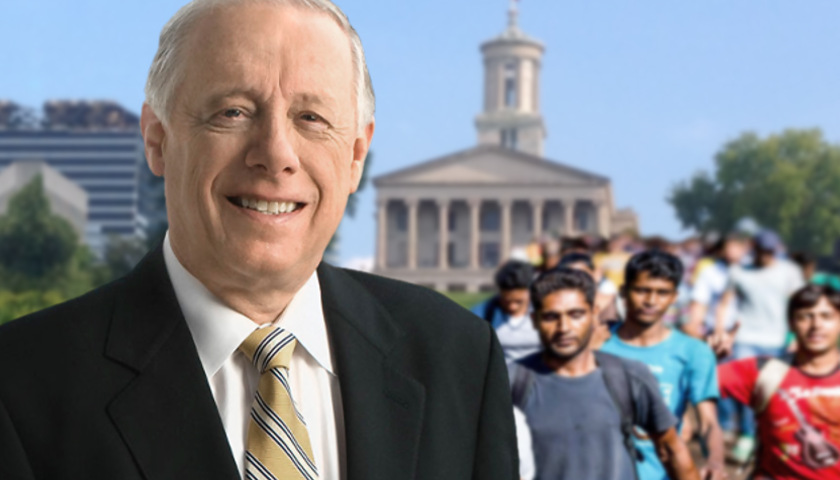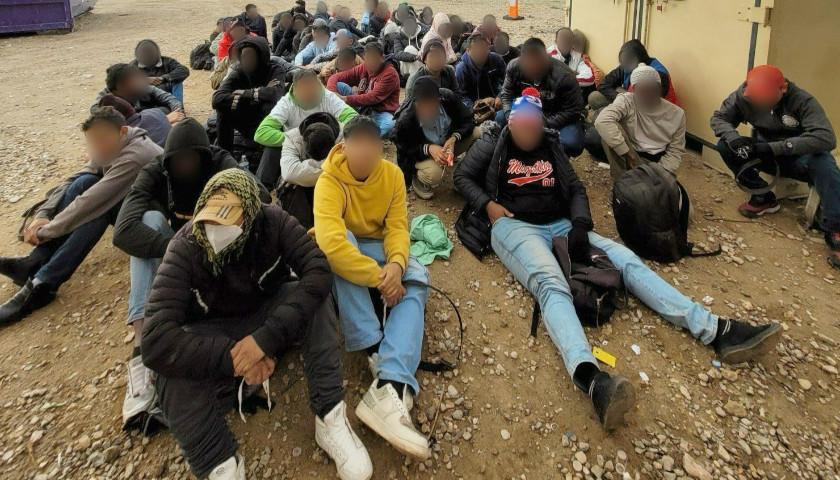When he was governor of Tennessee from 2003 to 2011, Phil Bredesen set the state up to receive a dramatically higher number of refugees – an increase well into the thousands – bringing with it significant financial benefit to federal refugee contractors like Catholic Charities of Tennessee and World Relief.
Early into Bredesen’s second term as governor, he withdrew Tennessee from the federal refugee resettlement program writing to the U.S. Office of Refugee Resettlement (ORR) that “refugee-specific service providers” could better meet the needs of arriving refugees.
By taking this step, Bredesen created the opportunity for the U.S. Office of Refugee Resettlement (ORR) to hand over running of the state’s program to Catholic Charities of Tennessee (CCTN) but without any accountability to the state legislature or the state budget.
The first full year during which CCTN administered the program in Tennessee, refugees arriving to the state increased from 847 to 1,492, despite a decline in refugee arrivals on a national level.
By 2010, with the new designation from the U.S. ORR and more federal funding, CCTN expanded its refugee operations and established its Tennessee Office for Refugees (TOR). This department was set-up to coordinate all refugee resettlement agencies operating in the state. CCTN’s annual reports show that TOR quickly became CCTN’s largest dollar program with $8,172,331 million dollars from U.S. ORR comprising over 50% of its 2009-2010 income.
CCTN’s own refugee resettlement program with funding from TOR and the U.S. State Department quickly grew to become the second largest dollar program.
During the next two years, the TOR office experienced a minor dip in U.S. ORR funding but surged in 2012 to over $9 million dollars making up 56.6% of CCTN’s income that year.
By 2016, when refugee arrivals to Tennessee had peaked at 1,959, U.S. ORR funding to CCTN reached a high of over $11 million dollars making up over 56% of the agency’s income. Between TOR and CCTN’s own refugee resettlement operation, expenditures related to refugees dominated the budget.
Refugee contractors are dependent on taxpayer funding to operate their resettlement activities. Because the contractors are paid a fee for each refugee they resettle, increasing the number of refugees automatically increases the agency’s cash flow. For example, in 2011, when Catholic Charities of West Tennessee resettled a Somali mother and her eleven children in Memphis, the agency was paid a fee for twelve refugees.
A 2012 U.S. General Accounting Office report confirmed that this payment structure incentivizes resettlement contractors “to maintain or increase the number of refugees they resettle each year rather than allowing the number to decrease.”
As evidence of the GAO’s assessment of the almost exclusive use of taxpayer funding for refugee resettlement, World Relief (WR) began closing local offices including one in Nashville, shortly after President Trump reduced refugee arrivals. A volunteer group helping refugees alleged that World Relief failed to provide essential survival services to the refugees they placed in Murfreesboro before the agency skipped town.
Between fiscal years 2016 -17, WR was paid over $40 million dollars by the federal government to resettle refugees in communities where they operate.
Instead of providing the contracted services, World Relief’s Nashville office used other area non-profits to do its work rather than use its own resources. In one proposal submitted by WR to the U.S. State Department in which they detail how many refugees they want to resettle, why they should be paid for this work and why Nashville is a desirable location for resettlement, they wrote:
The Nashville area offers numerous services through other non-profit organizations to refugees with critical and emergency needs. Refugees can visit the Nashville Rescue Mission for shelter, food and safety, as well as Room in the Inn which provides working men with a hot meal and a place to sleep during the winter months. There are several shelters for abused women in the area where refugee women and children can find safety if necessary. Rooftop Ministries provides one-time assistance with rent payments: Wherry Housing Complex in Rutherford County houses refugees and others recovering from alcohol and substance abuse and has a Community Servants program to meet refugee needs.
The Nashville Rescue Mission and Room in the Inn provide shelter to the homeless.
Bredesen was familiar with the work of refugee agencies operating in Tennessee. At the start of his first term as Mayor of Nashville in 1992, he signed an Executive Order reaffirming the Mayor’s Advisory Committee on Refugee and Immigration Affairs which included representation from each resettlement agency operating in Tennessee including CCTN and World Relief.
Whether or to what extent Bredesen himself or his wife Andrea Conte who is Catholic were more involved with CCTN is not known but during Bredesen’s first term as governor, he appointed Gregory Ramos, a former chairman of CCTN’s board and past president of Conexion Americas, to serve on a state advisory council.
Between 2003 and 2011, Bredesen’s last year as governor, over 9,000 refugees of multiple ethnicities were brought to Tennessee by federal contractors. The numbers do not, however, account for secondary migrants who are first resettled in other states or other parts of Tennessee but then relocate to follow friends, relatives or jobs and join the growing ethnic enclaves in a different location.
“[T]he simple action of offering hundreds of job openings at the local chicken processing plant” according to former Shelbyville Times-Gazette reporter Brian Mosely, explains in part, what drew Somali refugees to his hometown. When Bredesen set up Tennessee to receive increasing numbers of refugees, it helped increase the supply of refugee workers.
The “big meat” industry like Tyson Foods welcomes the cheap legal labor offered by the refugee resettlement program. Bredesen showed his support for the Tyson Foods expansion, attending the June 2018, ground-breaking ceremony for the new plant in Humboldt. His Facebook post took credit for helping to bring companies like Tyson Foods to Tennessee.
According to the National Republican Senatorial Committee, “[d]uring Bredesen’s Tenure As Governor, The Unemployment Rate In Tennessee Increased From 5.1 Percent To 9.5 Percent.”
Prior to Bredesen’s two terms as governor, only a handful of Somali refugees had resettled in Tennessee. Between 2003 and 2011, Bredesen’s last year as governor, 1,866 Somali refugees were resettled in Tennessee by federal resettlement contractors.
Last week, Mohamed Abdirahman Osman and Zeinab Abdirahman Mohamed, a husband and wife who entered the U.S. as refugees and were living in Arizona, were indicted on charges of lying on their applications that got them refugee status and later, their green cards. The indictment also alleges that the husband falsified information about his association with al-Shabaab, a U.S. designated terrorist group based in Somalia.
Last year, two Somali women who came to the U.S. as refugees in the late 1990’s, went to prison for providing material support to al-Shabaab by making monthly payments to support the terrorist group.






[…] contractors are dependent on taxpayer funding to operate their resettlement activities, as reported by The Tennessee Star. Because the contractors are paid a fee for each refugee they resettle, […]
[…] Tennessee Star in August 2018 reported that former Gov. Phil Bredesen, who was in office from 2003-2011, allowed an influx of refugees, […]
[…] Tennessee Star in August 2018 reported that former Gov. Phil Bredesen, who was in office from 2003-2011, allowed an influx of refugees, […]
[…] Tennessee Star in August 2018 reported that former Gov. Phil Bredesen, who was in office from 2003-2011, allowed an influx of refugees, […]
[…] As governor, Phil Bredesen increased refugee resettlement in Tennessee by thousands, bringing big money to ‘Non-Profits’ Catholic Charities and World Relief.” Tennessee Star […]
[…] 2003 and 2011, Bredesen’s last year as governor, over 9,000 refugees of multiple ethnicities were brought to Tennessee by federal contractors. The numbers do not, […]
[…] light of his demonstrated preference for high refugee admissions, The Tennessee Star asked the Bredesen campaign the […]
This is old news
Wonder how Phil feels about ICE? Since he’s Chuckie Schumer’s boy, he will have to toe the Democratic party line and that means more refugees from the Mid-east for the U.S. and a pass for illegal aliens.
Phil Bredesen has already stated that he will not vote party lines. If a bill is good for Tennessee then he will vote for it, no matter which party proposed it. He’s a moderate, not some crazed lunatic like Pelosi. He’s pro 2nd amendment, pro wall to stop illegals from entering the US, pro ICE and pro healthcare reform.
Didn’t I see a report here re: his multiple dwellings. So how many refugees for whom did Phil Bredesen provide resettement?
Just another very good reason to send Bredesen back to where he came from. He does not have the best interests of Tennessee and American citizens as his guiding objective.